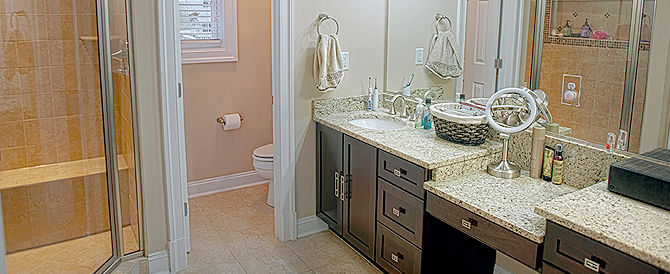A home remodeling project, like a new master bathroom, can add value to your home, but can also save you money on energy and water as well. In the first part of a two-part blog series on the Dos & Don’ts of Bathroom Remodeling, we’re going to focus on the seven steps that will help to ensure that your remodel is a dream, not a nightmare.
DO Budget for the unexpected.
Hidden water damage is a common problem in bathrooms, whether from a leaky shower pan or running toilet. Other issues are hidden, such as a vent stack inside a wall that you thought you were going to knock down.
An experienced contractor, like MDV Remodeling, will do exploratory work early in the project to sniff out as many issues as possible. But contractors can’t see through walls, so don’t expect them to catch every possible pitfall. That’s why the usual advice you hear is to build a 10 to 15 percent cushion into your budget. If nothing goes wrong, you’ll have a nice little windfall.
DO Hide the toilet.
A master bath that’s stylish and functional should also be discreet. That’s why it’s nice to hide the toilet away, either in its own “room-within-the-room” or behind a half wall. A piece of furniture, like an armoire or dresser, can create the necessary barrier without the expense of a framed wall.
DO Choose appropriate surfaces.
Your master bathroom’s surfaces do more than just contribute to the overall aesthetic, they also take lots of abuse simply through everyday use. Porcelain tile is a favorite among designers, for use on the floors and walls alike. Using larger tile sizes will help to minimize grout lines, easing the upkeep.
Porcelain is also a popular option for bathroom sinks, but can be prone to chipping. Other options include enamel-on-steel sinks which are especially durable and stain-resistant and stainless steel sinks. Solid-surface sinks are another durable option that allows the sink to be integrated with the vanity countertop and an adjoining cove or backsplash.
When it comes to the countertop, granite and quartz have become as popular for use in the bathroom as they are in the kitchen and deliver the same durability and visual appeal. Laminate and solid surface countertops are cost-effective options, though both can scratch easily.
DO Splurge on the shower.
One of the biggest design trends in bathrooms today is making use of the space available to create larger showers – often with his and her shower heads, body sprays, and even steam generators – over a bathtub.
To create this large shower experience, you’ll need a shower stall that measures at least 4-by-6-feet, rather than the standard 3-by-3-feet box. If you can take the stall up to 5-by-7-feet, you may also be able to do away with the door, since the shower head(s) can be directed in a way that the spray doesn’t reach beyond the shower area (an L-shaped design is helpful in achieving this). This will eliminate a sizable expense, especially if you were planning on a frameless door, which can be pricey.
One thing to consider, though – don’t eliminate the bathtub if there aren’t any other bathrooms in the house with a tub.
DO Consider water efficiency.
Shower heads, toilets, and faucets have all become more water-efficient in recent years, thanks to the Environmental Protection Agency’s (EPA) voluntary WaterSense program, which labels products that are 20 percent more efficient than federal standards. These EPA standards could save the average family of four 16,000 gallons of water and more than $100 per year if they’re replacing older, inefficient toilets and fixtures. Choosing a faucet with an aerator can reduce the water flow in your bathroom sink by 30% or more.
DO Make room on the vanity.
While the his-and-her double sink configuration has been popular in the past, it often makes sense to have a single sink and more counter space. Since so much is done at the vanity, it’s important to have plenty of surface area to put things down. Besides maximizing the counter space, opting for a single sink vanity saves you the expense of the second sink and faucet, as well as eliminating additional plumbing, which reduces storage space under the vanity.
DO Provide adequate ventilation and light.
Moisture not only breeds mold and mildew, it can take a toll on finishes and painted surfaces and a bathroom fan is the best defense against water damage. Consider a humidity
sensing unit that will automatically turn on and off depending on the amount of moisture in the air.
As for the lighting, a good idea is to bring different layers of illumination into the room. A ceiling fixture is suitable for general lighting, but it will cast shadows on your face when you’re working at the vanity. Wall sconces or other vertical fixtures mounted on either side of the vanity will help to add focused light when you need it most.
The shower and toilet, if you decide to segregate it, should also have a dedicated task light, such as recessed lighting. Consider fixtures that use LED bulbs and putting them on dimmer switches so that light levels can be adjusted depending on the mood and task at hand, while saving you money on your monthly electric bills.
With these seven areas in mind, you and your contractor should be able to design a beautiful, energy-efficient bathroom that is both luxurious and cost-effective. Check back next week for the second post of our two-part series, Bathroom Remodeling – Dos & Don’ts, Part 2: The Don’ts. Meanwhile, if you are ready to get started with your bathroom remodel, contact us today and set up a free estimate!

